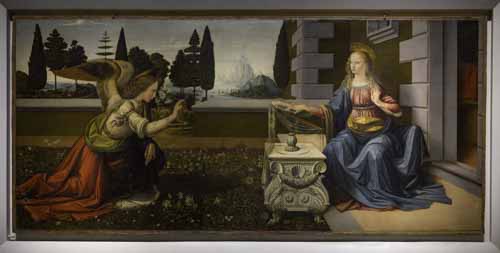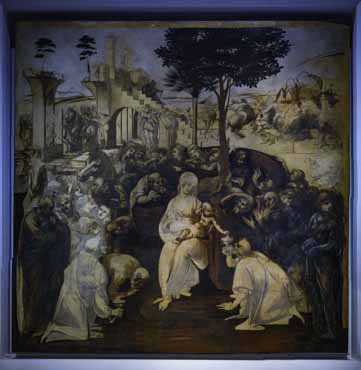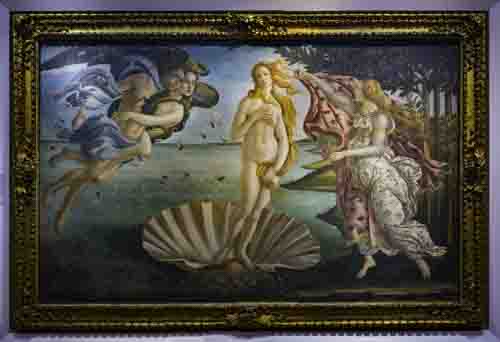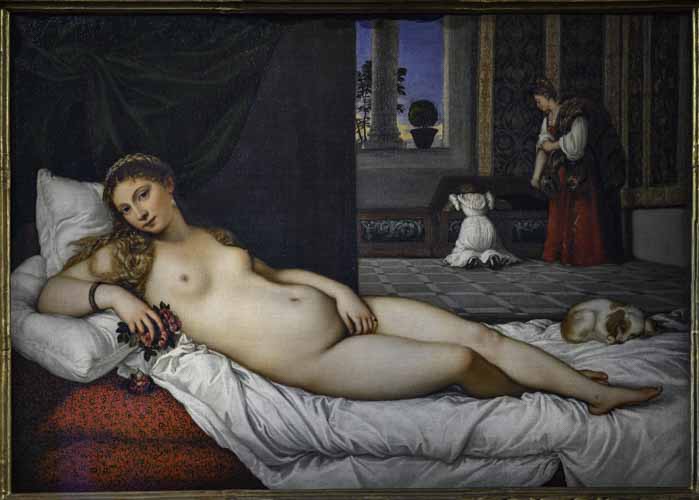Galleria degli Uffizi
Leonardo da Vince, Annunciation
| Leonardo da Vinci's "Annunciation" (c. 1472–1475) depicts the angel Gabriel announcing the Virgin Mary's destiny to bear Jesus. Unlike traditional portrayals in enclosed spaces, this scene unfolds outdoors. The Virgin sits behind a lectern, surprised by the kneeling Gabriel. Despite the religious theme, the figures are grounded with realistic details like the angel's bird-like wings and the architectural features. This early work showcases Leonardo's signature techniques like sfumato (hazy shading) and atmospheric perspective, creating a sense of depth and mystery. |
Leonardo, Adoration of the Magi
| The unfinished "Adoration of the Magi" (1481) depicts the biblical scene of the Magi visiting the newborn Jesus. Unlike traditional triangular compositions, Leonardo employs a more complex, semi-circular arrangement of figures. The Virgin Mary and Child are in the center, surrounded by kneeling and standing figures, possibly including a self-portrait of the young Leonardo. Sketches of fighting figures and a ruined building in the background hint at a world beyond the holy event. While details are unfinished, Leonardo's mastery of light and shadow, along with the dynamic composition, creates a captivating and enigmatic portrayal of the nativity scene. |
Sandro Botticelli, The Birth of Venus
| Sandro Botticelli's "The Birth of Venus" (c. 1484–1486) depicts the goddess Venus emerging from the sea, fully formed and graceful. She stands on a giant scallop shell, carried by the wind god Zephyr. A nymph drapes a cloak around her, symbolizing her entry into the world. This large-scale painting is a prime example of Renaissance ideals, with Venus embodying perfect beauty and proportions. The composition uses contrasting elements like calmness of Venus and the dynamic pose of Zephyr. The painting's soft colors and idealized figures create a serene and harmonious scene celebrating the arrival of love and beauty. |
| Sandro Botticelli's "Primavera" (c. 1480) is a masterpiece of the Italian Renaissance, depicting figures from classical mythology in a lush, springtime garden. The central figure, Venus, is flanked by the Three Graces and Mercury on one side, and Zephyrus, Chloris, and Flora on the other. The painting's allegorical themes may include love, fertility, and the harmony of nature, though its meaning remains debated. "Primavera" is celebrated for its intricate symbolism and elegant composition. |
| Titian's "Venus of Urbino" depicts a reclining nude woman, traditionally identified as Venus, in a lavish Renaissance palace setting. Unlike typical portrayals of Venus in mythical landscapes, she rests on a couch, gazing directly at the viewer. This frank depiction of female sexuality sparked controversy at the time. While erotic, the painting also celebrates marriage. The sleeping dog symbolizes fidelity, and a maid with a chest could represent future child-bearing. Its use of color, softness of form, and erotic overtones influenced many later works in Western art, such as Manet's ”Olympia“. |
| |




